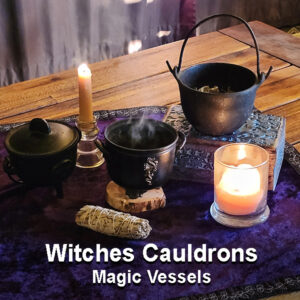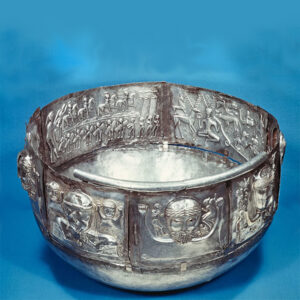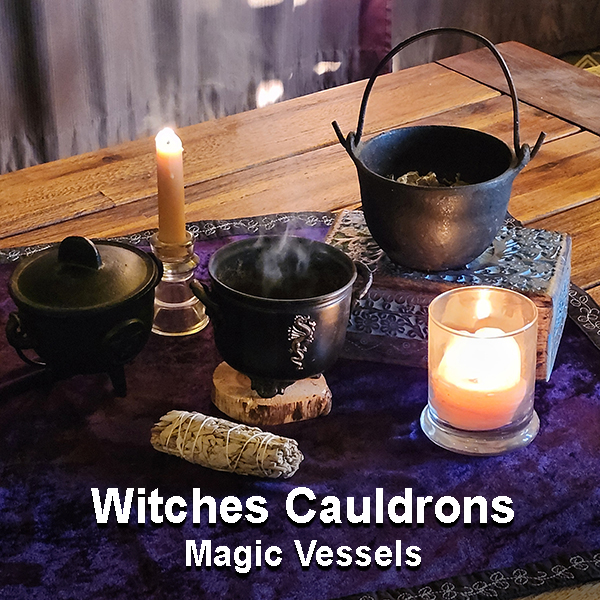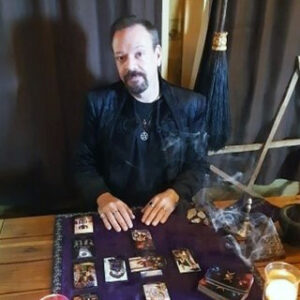
Three of my cauldrons
You must admit, witches’ cauldrons are iconic, practically inseparable from the image of a witch. It’s like you can’t be a witch without one bubbling away in the corner. But, let’s clear up one thing right out the gate—just about any fire-proof container, old pot, or pan can do the job. Honestly, I’ve been known to throw things into a beat-up soup pot and call it a day. Use it up, wear it out, make it do, or do without. That’s the motto I live by, even if it’s not exactly Instagram-worthy.
I confess I do have several cast iron cauldrons, different sizes and motifs, dedicated to specific uses. People (muggles) scratch their heads, wondering what cauldrons are actually for. I chuckle when they assume I’m brewing something sinister. It’s not rocket science, I promise.
Who doesn’t love cast iron witchy cauldrons with pagan designs? It’s practically witch law. How big a cauldron do you need? Well, I find cauldrons around 4-5 inches wide/tall serve all my magical needs just fine. I have several sizes, but that seems to be the most useful.
A little fun history, in Irish folklore, a cauldron is where leprechauns keep their gold. Not as sinister as a bubbling potion, right? In some forms of Wicca, which borrows aspects of Celtic mythology, cauldrons are associated with the goddess Cerridwen. Welsh legend tells of cauldrons useful to warring armies.
How about the Celtic god Dagda? He has that magnificent club, but also an ever-full cauldron used to share food with people. I always wonder if his wife, Danu, did all the cooking? A cauldron, you see, is not only functional but also symbolic of abundance and transformation. It’s a literal vessel of magic—and soup, if you’re practical like me.
Witches Cauldrons: Safety First
Now, before you rush off and buy the prettiest cauldron you can find, I need to throw a little caution your way. Make sure you acquire a sturdy cast iron cauldron. I’ve seen some highly decorative, but very flimsy cauldrons out there. They’re lovely to look at but useless for real work. If you’re just using it for decoration or some light incense burning, go for it. But if you plan to throw down with fire or boil anything, get the real deal.
We have many altar supplies on our site and in our metaphysical shop, come visit! Connect with us for more on Instagram, Facebook (Meta) or TikTok.
Another tip? Keep a wooden or soapstone plaque or disk under the cauldron if you’re burning things in it. This creates a heat buffer, so your altar cloth and altar don’t get scorched. Believe me, there’s nothing like the smell of singed altar cloth to ruin your ritual vibe. And remember, cast iron retains heat for ages. Don’t touch it unless you enjoy branding yourself with a pentacle pattern.
In those cauldrons I use to burn anything, I keep it about a quarter to a third full of earth from sacred space in my garden. This adds to the heat buffer, better grounding, stronger magic too. If you don’t have dedicated sacred space outdoors to procure earth from, use some from a special potted plant, though, I would enchant and consecrate the plant, earth and container first.
Cauldrons definitely have their place in rituals, but there’s a whole world of spellwork specific to them. I’ll cover that in more detail soon, but first, let’s dig into the history of witches’ cauldrons and why they’re more than just a spooky stereotype.
A little History of This Sacred Vessel
Cauldrons are practically icons in witchcraft, no surprise there. Many imagine bubbling cauldrons full of mysterious brews. But their history is more practical than mystical. Before becoming magic symbols, cauldrons were just big cooking pots. Medieval households used them for stews and boiling water. Picture a giant soup pot, except it was a lifeline for entire families. It was as much about survival as it was about sustenance.
In a way, every kitchen witch carries on this age-old tradition. They may not know it, but it’s true. Cauldrons weren’t always magical, though. They were tools—big, heavy, and unremarkable. It wasn’t until witches got a bad rap (thanks, Puritans) that these vessels became symbols of mystery. Some say it’s just propaganda, but I think the cauldron knew its purpose from the start. Tossing herbs into a cast-iron pot and feeling the energy shift is magic. Pure and simple.
The symbolism of the cauldron evolved over time. In alchemy, it represented transformation—a place where one thing becomes another. In folklore, it was linked to resurrection and abundance. The cauldron of Cerridwen, for example, was said to grant wisdom to those who drank from it. Talk about the ultimate life hack.
In fact, any old pot or pan can be effectively used as a cauldron. I keep some worn-out pots and pans for the heavy-duty and sometimes really oogie stuff. No need to be precious about it—magic isn’t picky.
Ritual Uses: Now, let’s get into the good stuff—how to use witches’ cauldrons.

Photo Courtesy of Nationalmuseet, Lennart Larsen
One Big Famous Cauldron
The Gundestrup Cauldron is basically the Iron Age’s version of a statement piece. Discovered in a Danish peat bog in 1891, this massive silver cauldron is the largest surviving piece of European Iron Age silverwork. It’s not just big—it’s flashy. Decorated with a bizarre mix of Celtic and Thracian motifs, it features gods, warriors, and even elephants and lions. Yes, elephants. In Denmark. Clearly, subtlety was not the goal.
Crafted primarily from silver with touches of gold gilding, tin solder, and glass, the cauldron is a masterpiece of ancient bling. Its panels show Celtic torcs, helmets, and war trumpets (carnyx), all hinting at some major cultural mash-up. Scholars still argue over its origins—some say Celtic, others claim Thracian, and a few just shrug and say “both.” But one thing’s for sure: it wasn’t just kitchenware. Most agree it was a religious offering, likely gifted, stolen, or both, before carefully deposited in that bog.
This pagan work of art is 17″ tall and can hold nearly 29 gallons. Dating back to 150–0 BC, it’s crafted from 13 silver plates. The hammered and gilded metal weighs nearly 20 lbs. The outer surface depicts large deities, smaller human figures, animals, and mythical creatures. Inside, various scenes unfold with human and animal figures. One interior panel illustrates a procession of warriors holding a carnyx, a type of Celtic war trumpet.
Why bury such a treasure? Well, Iron Age folks had a flair for dramatic sacrifices, and tossing this silver giant into the mud probably scored them some cosmic brownie points. Today, the Gundestrup Cauldron stands as a shiny, oversized reminder of how interconnected Iron Age Europe really was—and how much they loved a good decorative flex. Anyway, thought I’d throw that in for fun, back to a working witches’ cauldron.
Fire Magic and Transformation
A cauldron is perfect for fire magic. Cast iron withstands heat, so it’s great for burning herbs, paper, or petitions. Toss in your ingredients, light them up, and let the flames work their magic. The smoke from the cauldron carries your intentions to the universe—witchy air mail. I have one cauldron specifically dedicated to fire work, like when I burn Vesta powder. Thank the gods my neighbors haven’t called the fire department yet. All the heavy-duty burning happens in that cauldron. Trust me, it’s better that way.
If you’re feeling especially witchy, you can even add different herbs to the flames to enhance your spell. Bay leaves for protection, rosemary for cleansing, and lavender for peace. The best part? It smells amazing and makes you look like you know exactly what you’re doing.
On my altar, I keep a specific herbal blend. I burn a charcoal disk in my altar cauldron and during the course of ritual I add pinches of mixed herbs to the cauldron. Sometimes this is part of invoking god and goddess, other times it is to imbue my sacred space with certain energies.
I use mine a lot for smoke cleansing too, preparing spell candles, spell bottles or tools of the trade. I often burn sage and other herbs and leave it just outside as an offering to sprits and gods.
Water Rituals and Scrying
Cauldrons are perfect for water rituals too. Ever tried scrying? Fill the cauldron with water, add essential oils, and gaze into the depths. With patience (and luck), you might glimpse the past, present, or future. It’s not like the movies, though. Scrying takes practice—and more patience than we’d like to admit. I have one plain and perpetually clean cauldron for this purpose, though I prefer tarot, pendulums, and crystal balls for divination.
I would also like to add many witches use their cauldrons to make infusions. Boiling herbs and heating oils for consumption or anointing. There’s a ton of magic in that arena. I also love the ones that come shaped like little tea pot shaped cauldrons. How cute, and just right for solitary witches.
Some witches also set about burning some herbal bits in the bathroom to add to their ritual baths.
 Earth Magic and Burying Spells
Earth Magic and Burying Spells
Cauldrons are useful for burying spells too. Some witches use their cauldrons to hold items they plan to bury later. It’s like a magical waiting room—only with more dirt and less anxiety. Personally, I don’t do this, but I have little dedicated spaces around my witch-hut for the things that need to be buried or burned. I used to do that, but found my cauldrons were always overflowing with spell bits that had run their course. Guess that happens when you’re a professional witch and metaphysical shop owner.
Don’t forget to cleanse, consecrate and dedicate your cauldrons!
I’m getting closer to starting spells and magical workings in my blog, but foundational stuff first. I am, however, really looking forward to posting a ton of magic and spells for my readers. Coming soon, blessings!


 Earth Magic and Burying Spells
Earth Magic and Burying Spells



Should it be a good idea to use a certain cauldron and only use that when smoke cleansing and using the vesta powder? Is it a good idea to keep all the ashes and use them for something later?
Good question Meg 🙂 For myself, I have one “heavy duty” cauldron for burning, and that’s the one I use for vesta powder. I have another cauldron I use for smoke-cleansing items that I burn other things in like sage, resin etc. I have a third one that I use for burning offerings, wish and prayer papers etc. I save the ashes from all three for making black salt. I like to keep them separate, even though I burn stuff in three of my cauldrons. 🙂 But that’s just a personal preference and it feels right to me to have them dedicated to certain purposes. Some witches will use one cauldron for all magic involving fire, and another for wet stuff, infusions, potions etc. 🙂 It’s entirely up to you and how you wish to shape your own magical practices. 🙂
I found out quickly my first cauldron was too small. Since increasing my magic time I have found that I do need at least 2 more larger cauldrons. I will be acquiring those soon I’m sure. I do love employing 2 old pots I have to make lovely witchy oils, creams and very recently candles. I try to reuse wax when I can and make beautiful new candles for future use. I love that magic is therapy most days!!
Also, now I want soup!!!
🙂 Glad you are enjoying cauldrons Erika 😉 In the future, I’m going to be writing articles on cauldron magic, spells and rituals with them. Foundational stuff first. 🙂 Hint for you; dedicate cauldrons for any food-stuff related work like infusions, teas etc. I think about all the stuff that goes in my other vessels, and you don’t want to use one that is contaminated with potentially toxic residues. Blessings!
Very informative, I myself have only one cauldron at home and it stays on my alter. I do however have other items I use in place for my other needs (simmerpots and such) but after reading your informative blog I think I will be investing in a few more for other endeavors. Thank you for sharing your knowledge with the world.
🙂 You’re welcome Cassie 🙂 Glad my post was informative for you. My blog is still fairly new. What I’m attempting to do is layout “foundational witchcraft” first; principles, tools etc. Later on in the not too distant future I’m really looking forward to posting about spells and rituals.
I dont buy into all this cauldron safety talk. I say let the magic flow and embrace the risks! Whos with me? Lets spice things up in the witchy world! 🧙♀️🔥💫
Safety first, reckless magic is no joke. Embrace wisdom, not folly. Stay safe, fellow witches.
Isnt it fascinating how witches cauldrons have been used throughout history for both magic and practical purposes? I never knew they had such a rich and diverse history! 🔮✨ #MindBlown
Hey Ari, thank you! 🙂 I have to tell you though, my article is just the tip of the ol iceberg when it comes to cauldron magic and lore! I hope to be writing more posts on the lore of and magic with cauldrons.